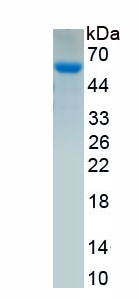Active Glucose-6-phosphate Dehydrogenase (G6PD)
Glucose-6-phosphate 1-dehydrogenase
- Product No.APA716Hu01
- Organism SpeciesHomo sapiens (Human) Same name, Different species.
- Buffer FormulationPBS, pH7.4, containing 0.01% SKL, 5% Trehalose.
- Traits Freeze-dried powder
- Purity> 90%
- Isoelectric Point6.5
- ApplicationsCell culture; Activity Assays.
- DownloadInstruction Manual
- UOM 10µg50µg 200µg 1mg 5mg
- FOB
US$ 180
US$ 450
US$ 900
US$ 2700
US$ 6750
For more details, please contact local distributors!
ACTIVITY TEST

Glucose-6-phosphate dehydrogenase (G6PD) converts D-glucose 6-phosphate (G6P) into 6-phosphoglucono-δ-lactone and generate co-enzyme nicotinamide adenine dinucleotide phosphate (NADPH). G6PD is the rate-limiting enzyme of the pentose phosphate pathway that supplies reducing energy to cells by maintaining the level of NADPH, which in turn maintains the level of glutathione in these cells that helps protect the red blood cells against oxidative damage from compounds like hydrogen peroxide. More importantly, NADPH is used for biosynthesis of fatty acids or isoprenoids. G6PD is generally found as a dimer of two identical monomers. Depending on conditions, such as pH, these dimers can themselves dimerize to form tetramers. Each monomer in the complex has a substrate binding site that binds to G6P, and a catalytic coenzyme binding site that binds to NADP /NADPH using the Rossman fold. Its activity is stimulated by the substrate G6P and NADP . The activity of recombinant human G6PD was measured by its ability to dehydrogenate glucose-6-phosphate. The reaction was performed in 25 mM Tris, 50 mM NaCl, 10 mM MgCl2, pH 8.0 (Assay Buffer), initiated by addition 50 μL of various concentrations of G6PD (diluted by Assay Buffer) to 50 µl substrate mixture consists of 1 mM NADP and 1 mM G6P. The final well serves as a negative control with no G6PD, replaced with 50 μL assay buffer. Then read at a wavelength of 340 nm in kinetic mode for 5 minutes. The specific activity of recombinant human G6PD is >280 pmol/min/µg.
USAGE
Reconstitute in 10mM PBS (pH7.4) to a concentration of 0.1-1.0 mg/mL. Do not vortex.
STORAGE
Avoid repeated freeze/thaw cycles. Store at 2-8°C for one month. Aliquot and store at -80°C for 12 months.
STABILITY
The thermal stability is described by the loss rate. The loss rate was determined by accelerated thermal degradation test, that is, incubate the protein at 37°C for 48h, and no obvious degradation and precipitation were observed. The loss rate is less than 5% within the expiration date under appropriate storage condition.
GIVEAWAYS
INCREMENT SERVICES
-
 BCA Protein Quantification Kit
BCA Protein Quantification Kit
-
 Molecular Mass Marker for Protein
Molecular Mass Marker for Protein
-
 Monoclonal Antibody Customized Service
Monoclonal Antibody Customized Service
-
 Polyclonal Antibody Customized Service
Polyclonal Antibody Customized Service
-
 Protein Activity Test Experiment Service
Protein Activity Test Experiment Service
-
 Electrophoretic Mobility Shift Assay (EMSA) Experiment Service
Electrophoretic Mobility Shift Assay (EMSA) Experiment Service
-
 Buffer
Buffer
-
 Lentivirus Packaging Experiment Service
Lentivirus Packaging Experiment Service
-
 Adenovirus Packaging Experiment Service
Adenovirus Packaging Experiment Service
-
 Real Time PCR Experimental Service
Real Time PCR Experimental Service
-
 Spike RBD Protein (S-RBD)
Spike RBD Protein (S-RBD)
-
 Protein G
Protein G
-
 Protein A
Protein A
| Magazine | Citations |
| Artificial Organs | Experimental Research With Synthetic Copolymer-Coated Cardiopulmonary Bypass Circuits: Inflammatory and Thrombogenicity Analysis Wiley: source |







